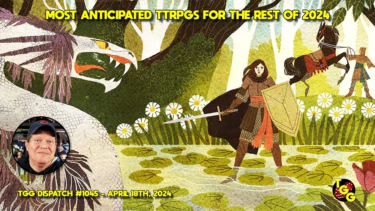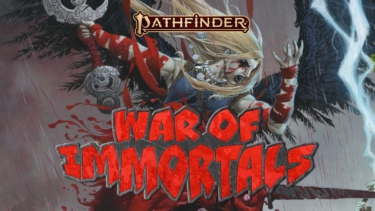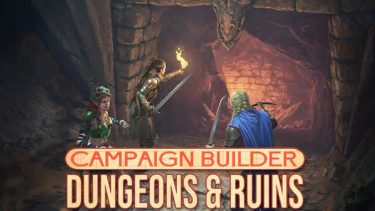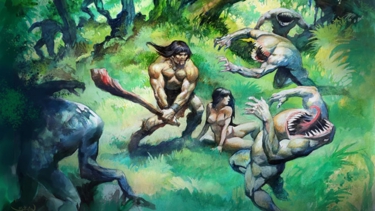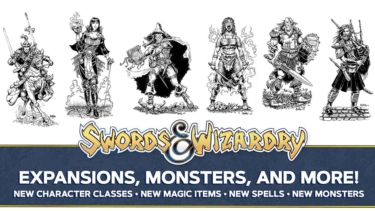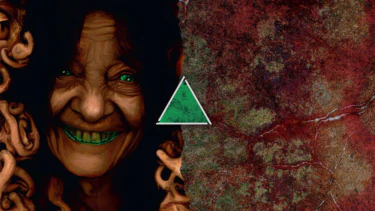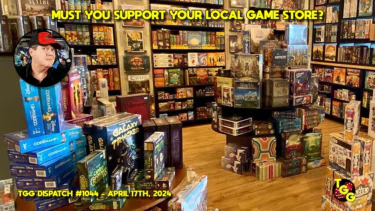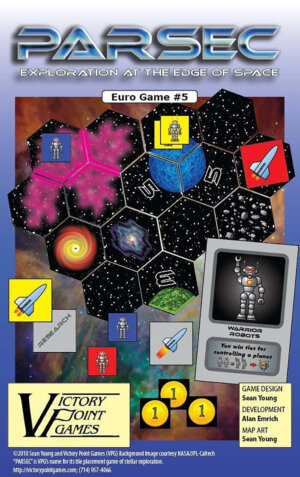
Publisher: Victory Point Games
Designer: Sean Young
Artist: Sean Young
Year: 2010
Players: Two to four players
Ages: 10+
Playing Time: 60-90 Minutes
Genre: Science fiction tile-laying game
MSRP: $34.95
Carcassonne in space, that’s what I think of when playing Parsec. I happen to love Carcassonne, so this isn’t a bad thing. It has a few more twists and turns to distinguish it though.
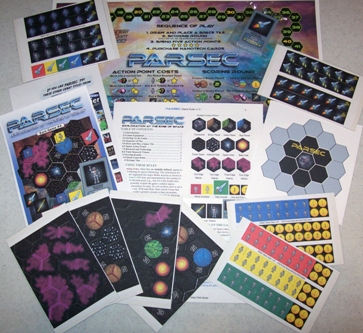
The components are standard VPG fair, either you will be ok with them or you won’t. The rules are short and fairly simple to learn. Probably the most difficult part to learn is the tile placement rules, which really isn’t all that bad. Planets come in three parts, and you can’t block a planet so that it cannot be completed. Similarly, nebula sides of tiles must connect only to other nebula sides, and black holes can’t be placed to block off other tiles completely. That’s really about it, so I guess it isn’t that difficult after all.
Players first select a set of one of four different colored tokens. You get a rocket ship, and 16 robot tokens. One of the robots goes on the zero space of the victory point track, and the others are considered to be on your rocket ship. These will be your meeples that you seed around the galaxy to earn your victory points.
The object of the game is to score the most victory points. Points are scored by controlling planets, and happen periodically during the game. As the 3rd, 5th, 7th, and 9th planets are completed, a scoring round occurs. After the scoring round following the 9th planet, the game is over. Whoever has the most victory points wins the game.
The game comes with a square card with the starting hexagonal space tiles printed on it. This represents Homeworld and the space around it. There are 12 starting tiles that are drawn and placed by the players one by one around Homeworld at the start of the game. This will set up the pieces of the first two planets that the players will fight over. All of the player’s rocket ships start in the center tile on Homeworld.
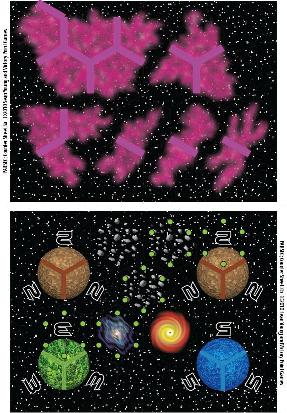
All of the remaining tiles are placed in a container and will be drawn randomly throughout the game. Planet tiles each have 1/3 of a complete planet on them, and come in three different colors. You can’t mix colors when placing a planet, so it takes three green planet tiles to complete a green planet. Controlling a brown planet will gain you three points during scoring, green gets three points, and blue gets five points.
Asteroid tiles cost an extra action point to move through, and they can earn you two credits for each asteroid tile controlled by a player. Nebulas can earn you research tokens, but only if you have control of a complete nebula. These can grow in size similar to a city in Carcassonne. Black holes cannot be moved through and will cost extra action points to move through any adjacent tiles. A space warp will allow you to move to any other empty tile on the board, and finally empty space is simply….empty.
During a turn, a player performs three phases. First, they will draw and place a new tile, expanding the known universe. If you select a planet tile, you must add it to any existing partial planet on the board of the same color. If a player completes a planet and it is one of the scoring round planets, then scoring takes place immediately.
During phase two most of the action occurs. A player gets five action points to spend. One point will move your ship one space, while more difficult terrain like asteroids and nebulas cost two action points to get through. You can beam one or more of your robots down to the tile you are on for one action point per robot, you can also beam robots back up to your ship if you need them somewhere else. The player who has the most robots on a planet has control of that planet, and will score the victory points during the scoring round.
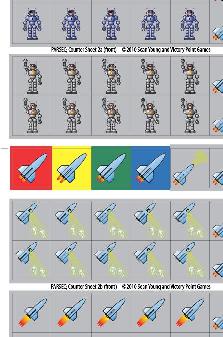
The final piece of the puzzle is the credits (money). Each player starts with three credits, and can earn more by controlling asteroid tiles or as a consolation prize if you have robots on a planet but not enough to control it during scoring. Credits can be spent at will to gain extra action points when you really need them.
Play proceeds and scoring occurs until the ninth planet is completed and the final scoring happens. It works a little differently during the final round, but when the scoring is over the player with the most victory points wins the game.
Much of the strategy comes from moving your robots about the galaxy, planets are all rescored during each scoring phase, so you’ll need to move your robots about to get the best advantage and maximize your points. This is the biggest difference from Carcassonne, as you don’t automatically get your robots back after scoring, and planets are scored more than once during a game.
The tiles are each about an inch, so make sure you play on a table that can’t be jostled about. The tiles are easily scattered around and it is hard to keep them together. The game is more fun with more players, as I found two players a snoozefest. Three and four players are much better and more strategic.
If you like Carcassonne type games and looking for a space themed version then you should like Parsec; frankly my biggest problem is the price point. I can buy Carcassonne for less then Parsec, and get glossy tiles and wooden meeples. This game just begs to be ported over to mobile.
- A Dungeon Delve for Kids?: A Review of Dungeon! - Oct 24, 2022
- Better, Stronger, Faster | Descent: Journeys in the Dark Second Edition Reviewed - Oct 23, 2022
- Your Planet is Doomed!: Invasion from Outer Space Reviewed - Oct 22, 2022



